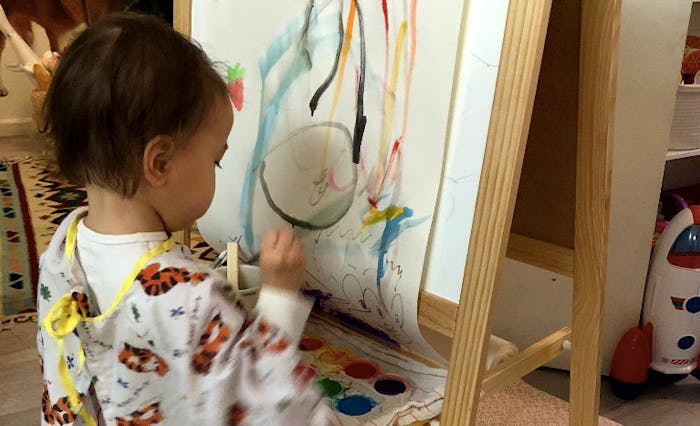Life

7 Genius Educational Toys For 2-Year-Olds, According To Experts
Say what you will about the terrible twos, but it's an age that fascinates me. I love hearing my newly minted 2-year-old express her thoughts and try to do "big kid" things. Since her mind seems like a total sponge right now, I figured it was the perfect time to introduce some new toys into our playroom. But when it comes to educational toys for 2-year-olds, you need to be discerning.
Like most millennial moms, I feel pressure to constantly expose my children to learning opportunities, so when I see a toy that promises "educational" or "brain boosting" activities, I must admit, it's more likely to make its way into my cart. But here's the kicker — there are no legal requirements for using the 'educational' label, according to Diane Levin, Ph.D., clinical professor of human development and early education at Boston University’s Wheelock College, speaking with Romper. Toy makers might not have any proof that the toy actually promotes learning.
That's why Dr. Levin suggests using a different set of criteria for selecting toys for your toddler: "[Look for] toys that will be used differently by every child, that build on what they’ve already done in the world and what they already know; that don’t have to be used in one particular way. That can grow and change as the child grows and changes."
The seven toys below have all been recommended by child development specialists, and promise real educational opportunities. And while the toys here might not seem as modern or high-tech as that latest interactive toy you saw in a recent commercial, they are what actually deserve the educational label. "Screen-based toys and games deprive children of opportunities for physical, sensory, personal, and creative exploration," Susan Linn, Ed.D., Lecturer in Psychiatry, Harvard Medical School and Research Associate, Boston Children's Hospital, tells Romper. And while there are on-screen apps and programs that can educate your child, nothing beats playing and engaging with toys IRL.
1Water or Sand Table
Have you ever noticed how kids are obsessed with water? Well, leaning into that interest is a good idea.
"The best toys for toddlers encourage their active and sensory exploration of the world, and nurture their burgeoning curiosity, creativity, and imagination. Sand, mud, and water are high on my list," explains Linn.
2Play-Doh
Any time I smell Play-Doh it transports me back to my own childhood. Talk about a toy with staying power. And there's a reason why the dough tends to bring out everyone's inner artist.
"Play-Doh can grow with the child. They can become a sculptor. But starting out, you can just push it and feel it and smoosh it... It’s just how it feels, it’s a sensory experience," explains Dr. Levin, who notes that she uses Play-Doh in her play classes at Boston University Wheelock for both play as therapy and play as learning.
3Kimochis Mini Mixed Feelings
Toys can be educational in all sorts of ways, including emotionally.
"Kimochis are a fun toy with the intent of helping a young child begin to name and identify their emotions, the very beginning of positive emotional health. I especially like the "Lovey Dove" where you can put the feelings in her pouch, or "Cloud" where you can do the same," Maureen Healy, children's emotional health expert and author of The Emotionally Healthy Child, tells Romper.
For my 2-year-old who is no stranger to tantrums, this activity seems very valuable.
4Duplos
Duplos are another great toy that can be use in different ways as the child grows.
"Try not to always follow the directions on the box. That takes a lot of the value away for younger children. Before they get to try to represent and make something look right, they should be playing with it, see how they relate to each other, what they can do with them, how can they vary it over time. That’s much more valuable," advises Dr. Levin.
And sparking that early interest in building is always a good idea. See below...
5Building Blocks
Building blocks are great at helping children solve problems and plan, according to the Infant and Toddler Play Guide put out by Teachers Resisting Unhealthy Children's Entertainment (TRUCE).
Importantly, blocks should be considered gender-neutral. "If boys think blocks are for me and girls think they’re not for them, boys are learning all kinds of skills about quantity, shape, organization, balance, and representation that are profoundly important for then getting more abstract when you get to letters and numbers," says Levin, who has worked with TRUCE for 25 years.
6Easel and Art Supplies
Introducing art supplies into the hands of an unpredictable 2-year-old can seem like a recipe for a big mess. But, art supplies encourage self-expression, according to Linn, so it's worth the clean-up time.
"Provide varied materials such as large pieces of chalk or crayons, finger paint, glue and collage material. Remember — the process is more important than the product," explains the TRUCE Infant and Toddler Play Guide.
Just remember to supervise the activity, or your walls might quickly become the canvas. My daughter's bedroom wall is a case in point.
7Doll (or Stuffed Animal)
Investing in a doll, stuffed animal, or lovey is a smart parenting move, no matter what your child's gender. "Stuffed animals, dolls, toy figures, dress up clothes [are] springboards for the kind of dramatic play that helps children wrestle with understanding and gaining a sense of competence over events in their lives and trying out new roles," explains Dr. Linn.
I know in my house, there is a stuffed dog named Donut who has become an official member of our family.
But no matter what toys you decide to introduce to your 2-year-old, making time to play and interact with your child is just as important as the toy itself.